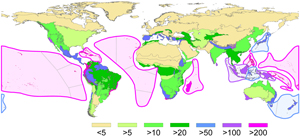Islands Top a Global List of Places to Protect
MAY 11, 2009
By Susan Brown

Biodiversity Map
Rare and unique ecological communities will be lost if oceanic islands aren't adequately considered in a global conservation plan, a new study by researchers in the Division of Biological Sciences and two universities in Germany has found. Although islands tend to harbor fewer species than continental lands of similar size, plants and animals found on islands often live only there, making protection of their isolated habitats our sole chance to preserve them.
Many conservation strategies focus on regions with the greatest biodiversity, measured by counting the number of different plants and animals. "Normally you want to focus on the most diverse places to protect a maximum number of species," said Holger Kreft, a post-doctoral fellow in the division and one of the two main authors of the study, "but you also want to focus on unique species which occur nowhere else."
To capture that uniqueness, Kreft and colleagues at UC San Diego, the University of Bonn and the University of Applied Sciences Eberswalde used a measure of biodiversity that weights rare species more than widespread ones. They carved the terrestrial realm into 90 biogeographic regions, calculated biodiversity for each, then compared island and continental ecosystems. By this measure, island populations of plants and vertebrate animals are eight to nine times as rich.
Their results, plotted on global maps, will be reported the week of May 11 in the Proceedings of the National Academy of Sciences.

Amborella Flowers
The southwest Pacific island of New Caledonia stands out as the most unique with animals like the kagu, a bird with no close relatives found only in the forested highlands that is in danger of extinction, and plants like Amborella, a small understory shrub unlike any other flowering plant that is thought to be the lone survivor of an ancient lineage.
Fragments of continents that have broken free to become islands like Madagascar and New Caledonia often serve as a final refuge for evolutionary relicts like these. The source of diversity is different on younger archipelagos formed by volcanoes such as the Canary Islands, the Galápagos and Hawaii which offered pristine environments where early colonizers branched out into multiple related new species to fill empty environmental niches. The new measure doesn't distinguish between the two sources of uniqueness, which may merit different conservation strategies.
"Islands are important and should be part of any global conservation strategy," Kreft said. "Such a strategy wouldn't make any sense if you didn't include the islands."
Although islands account for less than four percent of the Earth's land area, they harbor nearly a quarter of the world's plants, more than 70,000 species that don't occur on the mainlands. Vertebrate land animals - birds, amphibians, reptiles and mammals - broadly follow this same pattern.
These findings point to the importance of considering the uniqueness of an assemblage of species rather than the number of different species alone when prioritizing regions for conservation. "Hotspots of richness have had an intuitive yet potentially misleading appeal in conservation," said Walter Jetz, an associate professor of biology at UC San Diego and co-author of the study. "The combined knowledge about both diversity and restrictedness of species - and the consistency of these patterns across different groups - should drive much of our conservation decision-making. With this perspective, we come to appreciate the exceptional role of islands."
Threats to biodiversity may also rise faster for islands than for mainlands, the team reports. Scenarios based on a measure of human impact projected to the year 2100 warn that life on islands will be more drastically affected than mainland populations.
"That threat is expected to accelerate particularly rapidly on islands where access to remaining undeveloped lands is comparatively easy" said Gerold Kier, project leader at the University of Bonn and lead author of the study. Expanding farmlands, deforestation, and other changes in how people use land are among the alterations expected to cause the greatest damage.
The researchers also considered future challenges posed by climate change and report mixed impacts. Rising sea levels will swamp low-lying areas and smaller islands, but the ocean itself is expected to moderate island climates by buffering temperature changes. "Although disruptions to island ecosystems are expected to be less severe than on the continents, climate change remains one of the main threats to the biodiversity of the Earth," Kier said. "If we cannot slow it down significantly, protected areas will not be much help."
"We now have new and important data in our hands, but still have no simple solutions for nature conservation," Kreft said. "In particular, we need to answer the question of how protected areas with their flora and fauna can complement each other in the best way."
Additional co-authors included Tien Ming Lee of UC San Diego; Pierre Ibisch and Christoph Nowicki of the University of Applied Sciences Eberswalde; and Jens Mutke and Wilhelm Barthlott of the University of Bonn.
The Academy of Sciences and Literature Mainz, the US National Science Foundation, the Wilhelm Lauer Foundation, and the German Federal Ministry of Education and Research funded the research. Holger Kreft holds a Feodor-Lynen Fellowship from the Alexander von Humboldt Foundation.
Related Links